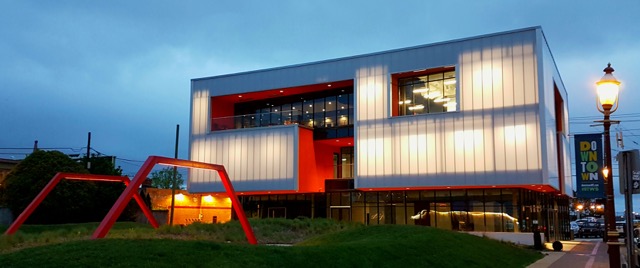By Chad Nance
“There is no forgiveness. For women. A man may lose his honor and regain it again. But a woman cannot. She cannot.”
― Cormac McCarthy, All the Pretty Horses

Landscape is normally the domain of the painter, the photographer, or the filmmaker. Theater is often a venue reserved for smaller narratives that unfold with a direct intimacy between viewer and the performers. Triad Stage’s new production of “Abundance” completely shatters both of those conventions giving the audience a distinct impression of the epic landscapes of the American West, while at the same time telling a story as intimate as a campfire chat.
Scenic Designer Robin Vest has found a way to convey the feeling of an expansive (and occasionally oppressive) landscape on stage at the Hanesbrands Theater. She has created a stage with no square edges- the backdrop a large, graceful swoop rather than a hard stop. Visually this allows for depth on the stage working like a 75mm film enveloping both the characters and the audience. The background is simple, resembling Japanese water color and even Plains Indian teepee marking. Laura Eckleman’s lighting design doesn’t simply illuminate the backdrop, she lights it from within and without providing a ghostly glow and reminding one of that moment in the American Plains just after the sun disappears below the horizon line, but the sky remains orange and gold before giving way to blue darkness.
The set remains simple and uncluttered with only a gnarled tree, a wooden table, and a few chairs used as both sets and props by the actors. Director Preston Lane’s blocking is stylized like the text itself, but has a muscular quality that allows for some of the more poetic and baldly archetypal moments to retain a sense of reality. This extends to the spare use of props and the way that chalk is used by the actors to write information and draw lines to represent buildings.
This device is reminiscent of the film “Dogville” by Danish filmmaker Lars Von Trier that has many of the same themes of oppression and bigotry as “Abundance”, yet is set in a Colorado small town. Von Trier used it to get out of the way of the actors and the story, and the director does the same here. Lane’s cast uses chalk to write “captions” for the audience, almost as if those were appearing on film at the bottom of the frame. This allows for the time period, settings, and the passage of time to be relayed to the audience without have to use ham-fisted expository dialog or an intrusive narrator. Make no mistake, “Abundance” is a Western with all of the traditional tropes, just deconstructed. Triad Stage’s production honors the genre and the incredible set design and staging allow for a truly cinematic and epic experience while at the same time fully realizing the intimacy of these incredibly human stories.
Playwright Beth Henley’s “Abundance” is technically a Deconstructionist Western in the vein of filmmaker Sam Peckinpah and author Cormac McCarthy. Henly not only lives in that bone bleached, and highly masculine world, she also stays firmly rooted in the quirky, and darkly humorous, Southern Gothic storytelling tradition. Henly’s target is not only the Manifest Destiny mythmaking that colored Western films and literature from the 1950’s, but the brutal exploitation of women and minorities that were the bloody foundations of western settlement. She presents the post Civil War expansion of America as the austere, violent, and lawless time it truly was while at the same time providing us with humanistically drawn female versions of Huck and Jim or George and Lenny from “Of Mice and Men”.

Amy Hamel and Roya Shanks play the story’s leads, Macon Hill and Bess Johnson respectively. Both actresses infuse their characters with a recognisable humanity. The 25 year scope of “Abundance” takes both characters through major character changes and convolutions spitting them out the other side scarred, wounded, but still surviving.
Amy Hamel’s work here is tremendous and Macon requires more subtly than is immediately apparent. When the audience and Bess first meet Macon she is a ball of nervous and hopeful energy. Macon has come West with a true heart in search of adventure and “The Elephant” as she calls it in a Kiplingesque way that serves as an echo- a technologically advanced people descending on an indigenous population in order to take their resources from them. Hamel’s sense of joy and wide-openness as Macon is charismatic, jubilant, and ready for anything. Hamel’s warm yet awkward physicality in the beginning reminiscent of real life Western figure Calamity Jane and she plays it for all it’s worth. The actress does not disappoint through Macon’s transitions. As Macon’s attentions are caught by bourgeois baubles and financial affluence and as she descends into degradation and poverty the core character remains. Hamel maintains Macon’s dignity and, hidden beneath heavy make-up and a soul crushing story-line, her humanity.
Roya Shanks’ role is showier and her life changes clearer on the surface, but her work here is no less exemplary. Her open-faced beauty and “proper” bearing (at least on arrival in the Wyoming Territory) set the benchmark from where we can watch Shanks take Bess from wide-eyed innocent to cynical manipulator without ever losing sight of the woman who makes her appearance in a brilliant moment of stagecraft and iconography that sets up all that is to come. Shanks is asked to go some dark places in “Abundance” and she never shies away. When she returns to white society following her capture and enslavement by a Sioux war chief, she appears like a combination of a spectre and a raw nerve. The physicality and silent work she does in those scenes cut deep and leave an indelible impression. The work Shanks does in the scene where she does finally realize that the tables have finally turned for her is tremendous and restrained in a way that only adds to the character’s authenticity.
The two husbands in the play have the burden of representing archetypes more than they are allowed to be fully realized human beings. This was a decision made in the writing process and remains one of “Abundance”’s flaws. Brent Bateman’s work as the more stalwart and industrious William Curtis is able. His teddybear cluelessness is carefully worked around a true heart. Bateman makes William Curtis pitiable and admirable in equal measure.
Zachary Clark’s work as the deadbeat Jack Flan is defined by the apparent choice to play him as a completely spineless mooch who doesn’t seem to have even the smallest redeeming quality- even buried somewhere deep. Clark’s physical approach is to play Flan as a man child who twists and contorts his face like a particularly petulant and vicious toddler. Overall the character has the arch of a pimp. His exploitation of Bess is almost total, even though he seems subservient to her by the play’s end. It is not an issue about whether Bess will or will not be exploited in some way… just how aware of and complicit with that exploitation she will be.
Triad Stage alum Jeremy Kuhn does solid work in the fairly thankless role of Professor Elmore Crome. A necessary plot device more than a character, Kuhn stays out of the way and doesn’t push the part to be something it isn’t. We need Crome, but the audience doesn’t really need to know who he is.

“Abundance” is about the women. The men and their experiences are secondary. In the end Beth Henley has not only turned the conventions of the Western genre on its head, she has also underlined many of the sexist and misogynistic problems with her male “Deconstructionist” counterparts like Peckinpah, Eastwood, and McCarthy. Those men saw the Western through their own fetishes and tended to mourn the passing of a time when “men could be men.” No matter how savage they painted the canvas there was still an elegiac romance. Henley shares none of that romance. In her west, men were men and able to act out their darkest wants and desires free from the constrictions of civilization. The losers in these encounters and conflicts were invariably women, racial minorities, and the original Americans themselves.
Triad Stage’s “Abundance” is an entertaining work of grand tragedy, dark humor, and imposing landscape. Even against the majestic and monstrous tableau of American expansion these two women remain. They are scarred, damaged, and still yearn for something just beyond the horizon. Macon Hill and Bess Johnson survive, even if making peace is something they will just never be able to do.
“Abundance” is running through May 17th. You can find showtime and ticket information HERE.
Share this:
- Click to email this to a friend (Opens in new window)
- Click to print (Opens in new window)
- Click to share on Facebook (Opens in new window)
- Click to share on LinkedIn (Opens in new window)
- Click to share on Reddit (Opens in new window)
- Click to share on Twitter (Opens in new window)
- Click to share on Google+ (Opens in new window)
- Click to share on Tumblr (Opens in new window)
- Click to share on Pinterest (Opens in new window)







